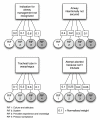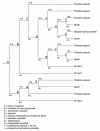Risk assessment of pre-hospital trauma airway management by anaesthesiologists using the predictive Bayesian approach
- PMID: 20409306
- PMCID: PMC2873366
- DOI: 10.1186/1757-7241-18-22
Risk assessment of pre-hospital trauma airway management by anaesthesiologists using the predictive Bayesian approach
Abstract
Introduction: Endotracheal intubation (ETI) has been considered an essential part of pre-hospital advanced life support. Pre-hospital ETI, however, is a complex intervention also for airway specialist like anaesthesiologists working as pre-hospital emergency physicians. We therefore wanted to investigate the quality of pre-hospital airway management by anaesthesiologists in severely traumatised patients and identify possible areas for improvement.
Method: We performed a risk assessment according to the predictive Bayesian approach, in a typical anaesthesiologist-manned Norwegian helicopter emergency medical service (HEMS). The main focus of the risk assessment was the event where a patient arrives in the emergency department without ETI despite a pre-hospital indication for it.
Results: In the risk assessment, we assigned a high probability (29%) for the event assessed, that a patient arrives without ETI despite a pre-hospital indication. However, several uncertainty factors in the risk assessment were identified related to data quality, indications for use of ETI, patient outcome and need for special training of ETI providers.
Conclusion: Our risk assessment indicated a high probability for trauma patients with an indication for pre-hospital ETI not receiving it in the studied HEMS. The uncertainty factors identified in the assessment should be further investigated to better understand the problem assessed and consequences for the patients. Better quality of pre-hospital airway management data could contribute to a reduction of these uncertainties.
Figures




References
-
- Advanced trauma life support for doctors ATLS: manuals for coordinators and faculty. Eight. Chicago, IL: American College of Surgeons; 2008.
-
- Smith CE, Walls RM, Lockey D, Kuhnigk H. In: Prehospital Trauma Care. Søreide E, Grande CM, editor. New York: Marcel Dekker; 2001. Advanced Airway Management and Use of Anesthetic Drugs; pp. 203–253.
-
- Walls RM, Murphy MF. Manual of emergency airway management. 3. Philadelphia, PA: Lippincott Williams & Wilkins; 2008.
-
- Winchell RJ, Hoyt DB. Endotracheal intubation in the field improves survival in patients with severe head injury. Trauma Research and Education Foundation of San Diego. Arch Surg. 1997;132:592–597. - PubMed
Publication types
MeSH terms
LinkOut - more resources
Full Text Sources
Medical

